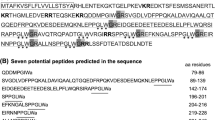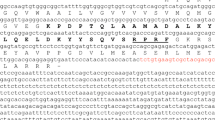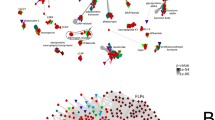Abstract
Metamorphosin A (MMA) isolated from the anthozoan Anthopleura elegantissima has recently been shown to interfere with developmental control in the colonial hydroid Hydractinia echinata. In order to identify the functional homologue in this species we have cloned cDNAs of the precursor protein from Hydractinia and, for comparison, precursor sequences from two further anthozoans. The deduced preproproteins contain multiple copies of propeptides to be processed into a great variety of novel neuropeptides most of which are N-terminally different from MMA. Original MMA is only contained in the anthozoan precursors. Most of the novel neuropeptides will have the carboxyl terminus LWamide. Therefore, we term this novel neuropeptide family the LWamides. Peptides synthesized according to the precursor sequence of H. echinata and added to planulae trigger metamorphosis. In contrast, none of 11 other known biologically active peptides including carboxamidated neuropeptides were effective. Expression analysis by in situ hybridization and by antibodies against the H. echinata peptide reveals the presence of the gene product in planulae at the proper time and at the due spatial location expected for a natural role in metamorphosis. LWamide transcripts are also observed in nerve cells of primary and adult polyps, suggesting LWamides to be a multifunctional family of neuropeptides.
Similar content being viewed by others

References
Aviv H, Leder P (1972) Purification of biologically active globin messenger RNA by chromatography on oligo-thymidylic acid-cellulose. Proc Natl Acad Sci USA 69:1408–1412
Baader CD, Heiermann R, Schuchert P, Schmid V, Plickert G (1995) Temporally and spatially restricted expression of a cell-specific gene during regeneration and in vitro transdifferentiation in the hydrozoan Podocoryne carnea. Roux's Arch Dev Biol 204:164–171
Berking S, Walther M (1994) Control of metamorphosis in the hydroid Hydractinia. In: Davey KG, Peter RE, Tobe SS (eds) Perspectives in comparative endocrinology. National Research Council Canada, Ottawa, pp 381–388
Bradbury AF, Smyth DG (1991) Peptide amidation. Trends Biochem Sci 16:112–115
Chirgwin JM, Przybyla AE, MacDonald RJ, Rutter WJ (1979) Isolation of biologically active ribonucleic acid from sources enriched in ribonuclease. Biochemistry 18:5294–5299
Devereux J, Heberli P, Smithies O (1984) A comprehensive set of sequence analysis programs for the VAX. Nucleic Acids Res 12:387–395
Devi L (1991) Consensus sequence for processing of peptide precursors at monobasic sites. FEBS Lett 280:189–194
Eipper BA, Stoffers D, Mains RE (1992) The biosynthesis of neuropeptides: peptide α-amidation. Annu Rev Neurosci 15:57–85
Fischer WH, Spiess J (1987) Identification of a mammalian glutaminyl cyclase converting glutaminyl into pyroglutamyl peptides. Proc Natl Acad Sci USA 84:3628–3632
Fricker LD, Adelman JP, Douglass J, Thompson RC, Strandmann RP von, Hutton J (1989) Isolation and sequence analysis of cDNA for rat carboxypeptidase E [EC 3.4.17.10], a neuropeptide processing enzyme. Mol Endocrinol 3:666–673
Grimmelikhuijzen CJP, Rinehart KL, Jacob E, Graff D, Reinscheid RK, Nothacker H-P, Staley AL (1990) Isolation of L-3-phenyllactyl-Leu-Arg-Asn-NH2 (Antho-RNamide), a sea anemone neuropeptide containing an unusual amino-terminal blocking group. Proc Natl Acad Sci USA 87:5410–5414
Grimmelikhuijzen CJP, Carstensen K, Darmer C, Moosler A, Nothacker H-P, Reinscheid RK, Schmutzler C, Vollert H (1992) Coelenterate neuropeptides: structure, action and biosynthesis. Am Zool 32:1–12
Grimmelikhuijzen CJP, Darmer D, Schmutzler C, Reinscheid RK, Carstensen K (1994) Biosynthesis of neuropeptides in the Cnidaria: new discoveries of old principles. In: Davey KG, Peter RE, Tobe SS (eds) Perspectives in comparative endocrinology. National Research Council Canada, Ottawa, pp 97–108
Heijne G von (1986) A new method for predicting signal sequence cleavage sites. Nucleic Acids Res 14:4683–4690
Kozak M (1989) The scanning model for translation: an update. J Cell Biol 108:229–241
Kozak M (1991) An analysis of vertebrate mRNA sequences: intimations of translational control. J Cell Biol 115:887–903
Kreil G (1990) Processing of precursors by dipeptidylaminopeptidases: a case of molecular ticketing. Trends Biochem Sci 15:23–26
Krieger TJ, Mende-Mueller L, Hook VYH (1992) Prohormone thiol protease and enkephalin precursor processing: cleavage at dibasic and monobasic sites. J Neurochem 59:26–31
Kyte J, Doolittle RF (1982) A simple method for displaying the hydropathic character of a protein. J Mol Biol 157:105–132
Leitz T (1993) Biochemical and cytological bases of metamorphosis in Hydractinia echinata. Roux's Arch Dev Biol 116:559–564
Leitz T, Wagner T (1992) The marine bacterium Alteromonas espejiana induces metamorphosis of the hydroid Hydractinia echinata. Mar Biol 115:173–178
Leitz T, Lay M (1995) Metamorphosin A is a neuropeptide. Roux's Arch Dev Biol 204:276–279
Leitz T, Morand K, Mann M (1994) Metamorphosin A, a novel peptide controlling development of the lower metazoan Hydractinia echinata. Dev Biol 163:440–446
Loh JP, Beinfeld MC, Birch NP (1993) Proteolytic processing of prohormones and proneuropeptides. In: Peng-Loh Y (ed) Mechanisms of intracellular trafficking and processing of pro-proteins. CRC Press, pp 179–224
Maruthainar K, Loh YP, Smyth DG (1992) The processing of β-endorphin and a-melanotropin in the pars intermedia of Xenopus laevis is influenced by background adaption. J Endocrinol 135:469–478
Mount SM (1982) A catalogue of splice junction sequences. Nucleic Acids Res 10:459–472
Müller WA (1969) Auslösung der Metamorphose durch Bakterien bei den Larven von Hydractinia echinata. Zool Jahrb AN Anat Ontog Tiere 86:84–95
Pawlik JR (1992) Chemical ecology of the settlement of benthic marine invertebrates. Oceanogr Mar Biol Annu Ref 30:273–335
Peeters JM, Hazendonk TG, Beuvery EC, Tesser GI (1989) Comparison of four bifunctional reagents for coupling peptides to proteins and the effect of the three moieties on the immunogenicity of the conjugates. J Immunol Meth 120:133–143
Plickert G (1989) Proportion altering factor (PAF) stimulates nerve cell differentiation in Hydractinia echinata. Cell Diff Dev 26:19–28
Proudfoot NJ, Brownlee GG (1976) 3′ Non-coding region sequences in eucaryotic messenger RNA. Nature 263:211–214
Rholam M, Brakch N, Germain D, Thomas DY, Fahy C, Boussetta H, Boileau G, Cohen P (1995) Role of amino acid sequences flanking dibasic cleavage sites in precursor proteolytic processing. Eur J Biochem 227:707–714
Sambrook J, Fritsch EF, Maniatis T (1989) Molecular cloning: A laboratory manual, 2nd edn. Cold Spring Harbor Laboratory Press, Cold Spring Harbor, New York
Sanger F, Nicklen S, Coulson AR (1977) DNA sequencing with chain-terminating-inhibitors. Proc Natl Acad Sci USA 74:5463–5467
Schaefer M, Picciotto MR, Kreiner T, Kaldany R-R, Taussing R, Scheller RH (1985) Aplysia neurons express a gene encoding multiple FMRFamide neuropeptides. Cell 41:457–467
Schaller HC, Bodenmüller H (1981) Isolation and aminoacid sequence of a morphogenetic peptide from Hydra. Proc Natl Acad Sci USA 78:7000–7004
Schulte-Merker S, Ho RK, Herrmann BG, Nüsslein-Volhard C (1992) The protein product of the zebrafish homologue of the mouse T gene is expressed in nuclei of the germ ring and the notochord of the early embryo. Development 116:1021–1032
Schwoerer-Böhning B, Kroiher M, Müller WA (1990) Signal transmission and covert prepattern in the metamorphosis of Hydractinia echinata. Roux's Arch Dev Biol 198:245–251
Senapathy P, Shapiro MB, Harris NL (1990) Splice junctions, branch point sites and exons: sequence statistics, identification and applications to genome project. Methods Enzymol 183:252–278
Song I, Chuang CZ, Bateman RC Jr (1994) Molecular cloning, sequence analysis and expression of human pituitary glutaminyl cyclase. J Mol Endocrinol 13:77–86
Sossin WS, Fisher JM, Scheller RH (1989) Cellular and molecular biology of neuropeptide processing and packaging. Neuron 2:1407–1417
Wickens M (1990) How the messenger got its tail: addition of poly(A) in the nucleus. Trends Biochem Sci 15:277–281
Author information
Authors and Affiliations
Rights and permissions
About this article
Cite this article
Gajewski, M., Leitz, T., Schloßherr, J. et al. LWamides from Cnidaria constitute a novel family of neuropeptides with morphogenetic activity. Roux's Arch Dev Biol 205, 232–242 (1996). https://doi.org/10.1007/BF00365801
Received:
Accepted:
Issue Date:
DOI: https://doi.org/10.1007/BF00365801



